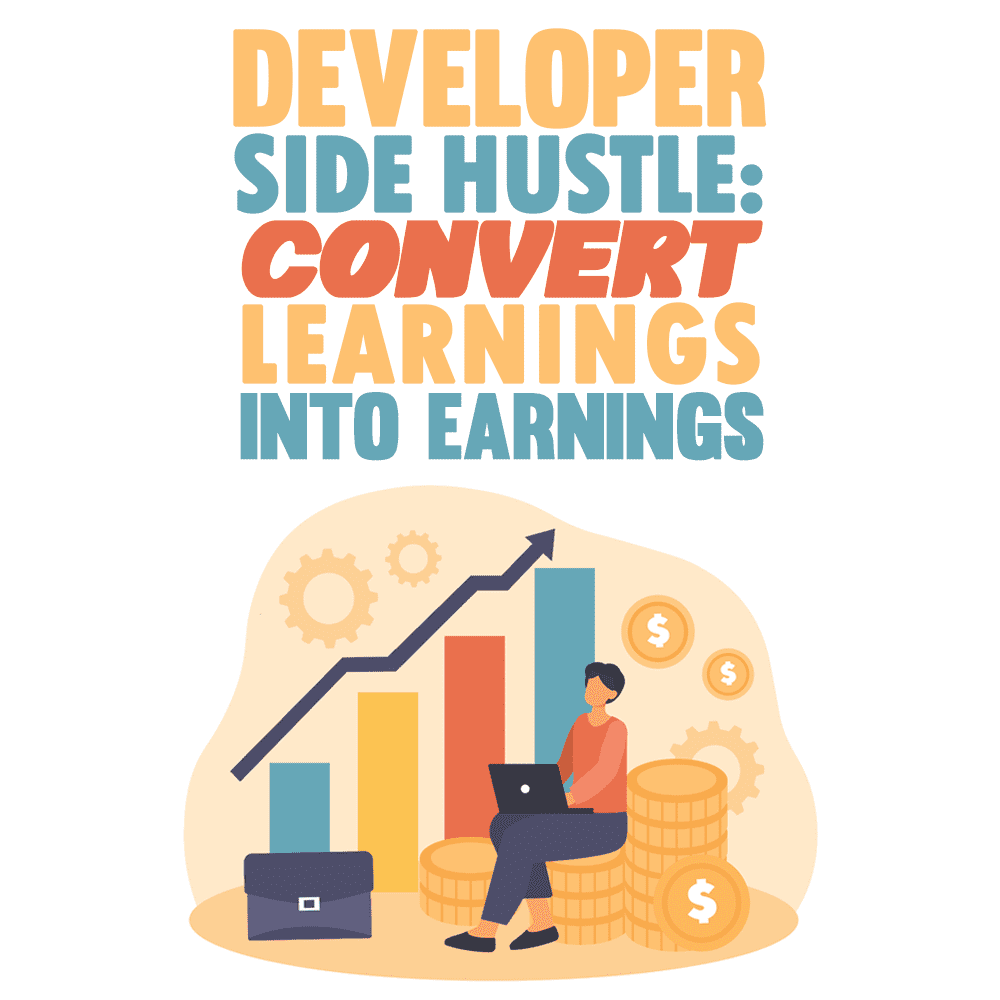
I wish that were so. This blog post will talk about sharing your learnings, when to share, where to share, and how you might turn those learnings into more significant earnings both as products you can sell or as space to sell advertising.
Why Share
Why is sharing your learning important?
First, it reinforces your learning. Before you can explain something to someone else, you have to make sure it's straight in your head. Stickiness is great in case you have to respond to a technical question at the team building tiki bar.
Second, it allows you to provide value to others and position yourself as an expert. The people who are seen as experts earn more money.
When you can show others that you know what you are talking about, they are more likely to:
- Pay attention to you
- Value your opinion
- Seek you out for advice and mentorship
- Offer you opportunities
- Promote your ideas
And finally, it's a way of giving back to the community that has helped you so much. We have all been there, and someone helped us when we started, and now it's our turn to help others. It feels good, and it's the right thing to do.
Step One: Identify When You are Learning
The first step to translating your learning into earning is to realize you are learning. How many times a day do you have to look something up or work out a tricky problem? Each of these times is you learning something.
The main idea here is to be aware that you are learning. So, in the beginning, note it in your mind. In the book Atomic Habits, James Clear lets us know that we can start to build impressive habits by consistently doing the tiniest possible things first.
Throughout your day, look out for times when you:
- Have an “Aha!” moment.
- Think to yourself, “That's funny.”
- Look something up
- Think to yourself, “Well, it works on my machine.”
- Work out a tricky problem
- Discuss with a co-worker on solving an issue
- Tell someone else how to do something you just learned
Each of these times, note it's something you learned. Then, if you can get in the habit of recognizing when you are learning, you can start to take action and turn that learning into earning.
Earnings: Very little as all this is happening in your head.
Step Two: Capture Your Learning
After you have developed a habit of acknowledging when you have learned something, start keeping notes on what you learned. Jot down the problem and how you solved it, so you don't forget later.
Keeping notes has three benefits:
- It reinforces the learning for you immediately. Reinforcement means you are less likely to forget the solution, and in this way, you strengthen your knowledge.
- You have notes to allow you to reinforce your learning in the future. If this is a critical concept, you should place the idea in a Spaced Repetition System (SRS) like Anki.
- You have a reminder of things you have learned so you can share them publically later.
Once again, take this tiny step, and this step only, building on the previous phase of acknowledgment until you are consistently doing it over 2 weeks.
Earnings: Small. If you are only capturing it in a physical notebook it is the start of something you could turn into earnings, but you aren’t there yet.
Step Three: Share Your Learning In a Small Way

Twitter is the perfect platform for sharing little snippets of information, or what I like to call “micro-teaching.”
The next habit to build is to share one thing you learned on Twitter each day. Please take one of your notes, condense it into a Tweet, and put it there. Do this every day or every workday for a few weeks.
If you aren't brave enough to expose your ignorance to the world (guess what, everyone is ignorant of something), you can anonymously start a Twitter account and post there.
After a few weeks of this, you have built up a small but steady habit of sharing our learning with the world in a very low-risk way.
Earnings: Small to medium. You aren’t going to earn much, if anything, on Twitter but if you do this long enough you could position yourself as an expert and turn it into a new better fulfilling or paying job.
Step Four: Consolidate Your Sharing Into Something Larger
Next, you take one of our learning notes that is not condensible to a single Tweet and build it into a Tweet thread.
Or you could provide a summary of the previous 4 or 5 days of tweets if they are all related.
Let's plan to do this once a week, in addition to our daily tweets.
Lists are great things to present in tweet threads. For example, think of the initial tweet as saying: “The X Best Tools for Y,” or “X Good Things and Y Bad Things about Product Z I Learned This Week.”
People like lists, it's easy to get their head around, and it makes it easier for you to structure what you want to say. Making things easier for you to produce them means it's more likely you will make these tweet threads a habit.
Another thread type is the “How-To.” These are more difficult to produce, but they provide immense value to your followers if you can make them a habit.
The last thread type is the story. If you have a good story related to your work or learning that would be interesting to others, share it! Stories are great because they are entertaining and provide a great way to share your learning in an easily digestible format.
The key with these thread types is to make sure you are providing value to your followers, not just promoting yourself or your product.
If you can do that, people will appreciate it, and you will build a following of engaged users who are happy to see your content.
As you can see, we have now built on the previous two habits to get to a point where we are sharing our learning with the world more substantially, once a week.
But it doesn't stop there.
Earnings: Small to Medium. Still the same reasons as above, but showing people you are willing to work harder at sharing increases the chance of opportunities coming your way.
Step Five: Consolidate Your Consolidations to Something Larger Still
Now we can start to look at ways of turning our micro-learning into something that has more value.
The next step is to start writing articles. Article writing is a big one and will take some time to get used to, but it's worth it. The main idea is to take one of your tweet threads, or a selection of them, and turn it into a longer article.
Articles are easier to build than you think, as you already have the content created. You need to expand on your tweets and tweet threads and link everything together.
Articles are a great way to share your learning in a more permanent format with the world. They also benefit from being easily shareable on social media and other platforms.
Suppose you can write one article per week, 52 articles per year! And if each of those articles helped just one person, that would be 52 people whose lives you have made a little bit better.
Think about how good that would make you feel in addition to who might get exposed to it and who might like your work enough to want to work with you via consulting, a job offer, writing a book together, or something else.
We want to build this habit of writing an article once a month to start and eventually bringing it down to once a week.
Where do you publish these articles?
Medium (Or Other Places)
Medium is a great place to start. You have a built-in audience, and if you start getting traction, you can redirect them to your blog (below).
The downside of Medium is they own the content, and they own your subscribers.
Other great places to post these are on sites like Hashnode, freeCodeCamp, and dev. These websites already have large audiences of developers interested in reading this type of content.
Posting on other people's sites is a great place to start, but if you want long term control and success, you are going to have to:
Start A Blog
A personal blog is a great way to share your learning with the world more substantially.
Not only do you control everything, but you can also go as deep into topics as you like and show off what you know. There are no editors, no style guides, and no limits. There's also little support. I only suggest this after you have developed the habit of writing regularly and have an audience willing to follow you.
It's also a great way to build an audience of people interested in what you have to say.
WordPress.com is a great place to start if you want to go this route, as it's free and easy to set up. You can get your domain and host for around $48/year if you want more control. There are lots of tutorials out there on how to get started blogging.
You can start earning money on your articles with affiliate marketing or ad revenue, but the real money comes in the next step.
Earnings: Medium to Large. Ad revenue and affiliate marketing can be very lucrative in the right niches and with the right programs.
Step Six: And To The Earnings

Here are some ideas:
- Write a book
- Start a podcast
- Make a video course
- Create templates or project starters
- Give a talk at a conference
- Solo consulting
- The world is your oyster!
Earnings: Large. In addition, a lot of these are passive income streams that allow you to continue learning and sharing and the cycle repeats itself.
Now You Know, So Go Share and Earn
Learning and sharing is the path I have chosen to greater financial freedom, and it's the one I recommend you take as well.
The key is to get started and make sharing your learning a habit – that is, you do it consistently. Focus on habit building, small steps at a time, recognize you learned something, write it down, share it on Twitter, share longer Twitter threads, then write articles, and finally, start creating your own courses or products. The sooner you start, the sooner you will reap the rewards of greater earnings. Why are you waiting? Go out there and start sharing your excellent learning with the world!
